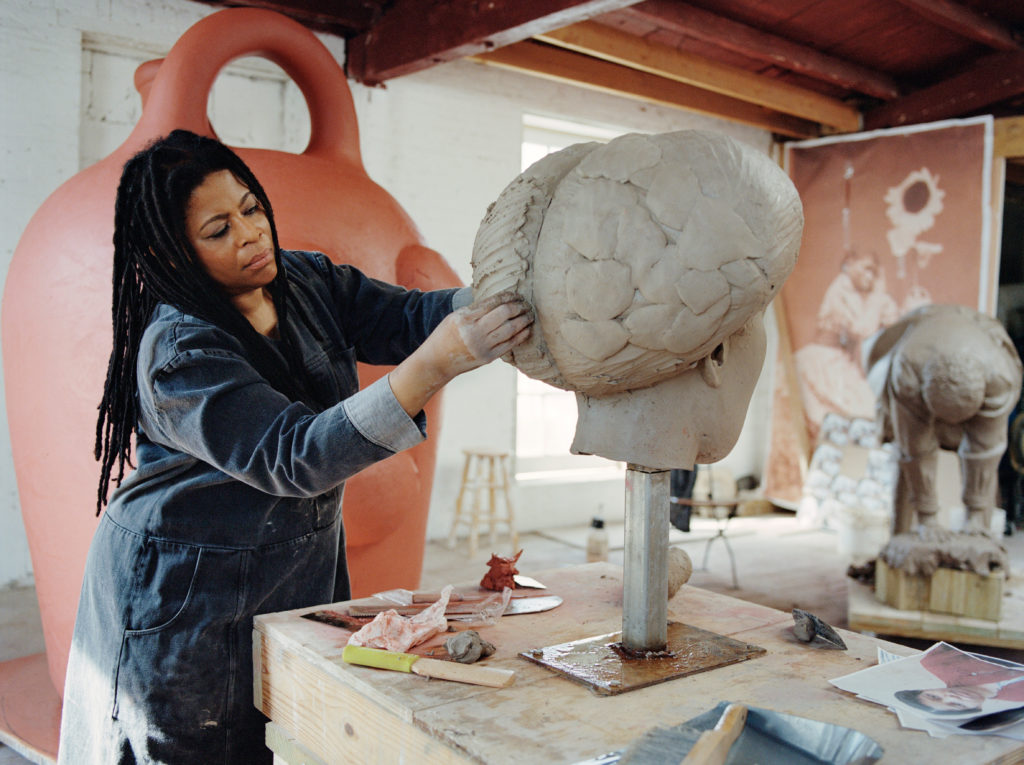
Simone Leigh, 2021. Photo by Shaniqwa Jarvis. Courtesy of the artist.
By Sheila Wickouski
A remarkable new exhibit at the Hirshhorn Museum, the first museum retrospective of the work of Simone Leigh, is akin to walking through a memoir of the renowned sculptor’s life.
The exhibit, on view through March 3, 2024, begins at the Hirshhorn’s entrance, which is dwarfed by Satellite (2022), a 24 foot by 10 foot by 7 foot bronze from Leigh’s presentation at the the 59th International Art Exhibition of La Biennale di Venezia in 2022.
Leigh was the first Black woman artist to represent the United States at this event. She has stated her message in the variety of media and forms of her works most clearly: Black feminism represented in auto-ethnography, or the use of personal experience to interpret culture. Her images in sculpture and pottery referencing African art and architecture and the American diaspora are rich in the employment of everyday objects, but never simplistic in expressing the marginalization of women of color.
The Hirshorn exhibition gives visitors the opportunity to explore the variations and themes of Leigh’s work as she transforms houses, jugs and spoons into artistic representations of women’s bodies.
Cupboard (2022) fuses domestic jugs or pots of stoneware into a faceless head atop a steel support covered by raffia palm, which reminds of a dwelling place, or the idea of a body as a place of refuge. The towering bronze Sentinel IV (2022) represents a West African water spirit, a destructive as well as creative generative deity, with a spoon-like head, referencing domesticity and a symbol of women’s labor.
Sleek bronze sculptures like Bisi, (2023) Herm (2023) and Vessel (2023) stand well over human height and small works of stoneware like 102 (Face Jug Series) (2018) provide reflection on ancient forms as represented in contemporary works.
Leigh’s artistic vision solidifies her studies of both Black women feminist writers and her deep knowledge of artistic material like clay and ceramics. Objects like pottery jugs with human faces have a history, from power objects in African art to” face jugs” produced by 19th century Black potters in Old Edgefield, South Carolina. Thus, Leigh’s ideas of a pot and what it represents blends the personal and the political into a poetic form, conceptual ideas presented in distinct objects.
In a remarkably circular moment of personal history, Leigh once was a summer intern at the Smithsonian National Museum of African Art, just steps away from this major retrospective on the National Mall, where she was surrounded by African vessels and the opportunity to research what was written in European colonial histories.
A particularly dramatic work is the cobalt blue Martinique, (2022) a faceless recreation of the statue of Napoleon’s wife Josephine that previously stood in a municipal square in Martinique. The public statue was decapitated and stained with blood-red paint in 1991 and later irreparably destroyed by activists. Leigh’s referential work crosses historical periods, geographies, and traditions, transforming what was once presented in a public monument as a symbol of colonialism into this museum art work of stunning beauty.
Interspersed in this exhibit among her sculptures are collaborative videos, Conspiracy (2022) Breakdown (2011) and my dreams, my works must wait till after hell… (2011) which continue to address Black feminist issues with a focus on the contemporary art discourse, exploring ideas of race, beauty, and community in visual and material culture.
The infinite variety of Leigh’s works are a thrill to view, flowing between times in history with leaps which challenge the hierarchy of art history in its connection to human experience.
While statues and pottery have long been part of the art history discourse, Leigh is a contemporary American women artist who is writing the next chapter in the what has been the omission in traditional art textbooks with her powerful abstract works that weave together past and present, illusion and abstraction, in beauty of form in great works, in our time, for everyone.

